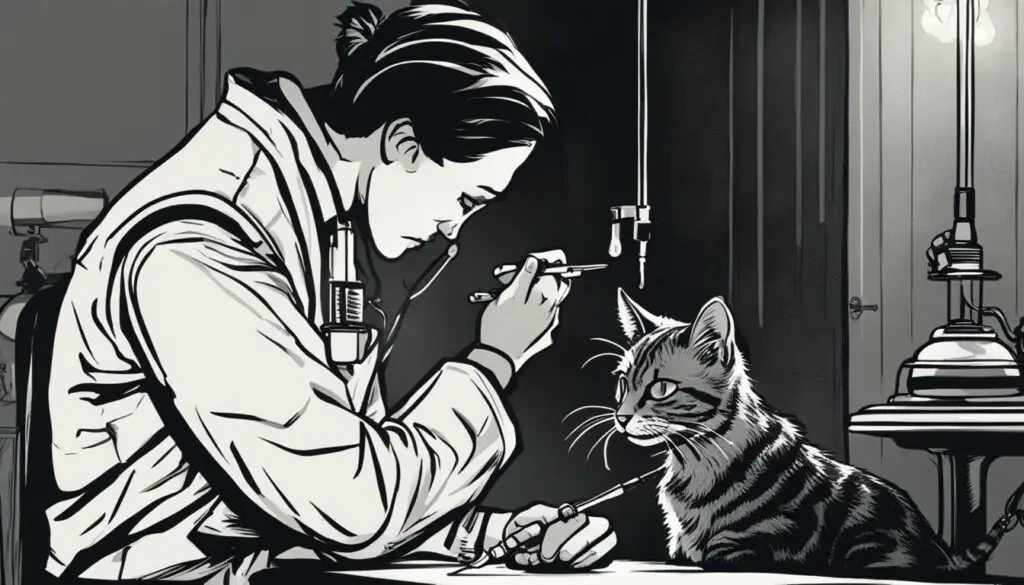Aggression in cats is a common behavioral problem that can be challenging for pet owners to navigate. When faced with an aggressive cat, one may wonder if a veterinarian will consider euthanizing the cat. In this article, we will explore this question and delve into the various aspects of managing aggressive cat behavior.
Understanding aggressive cat behavior is essential in addressing the issue effectively. Aggression can manifest in various ways, such as stalking, biting, and latching onto people. It is important to recognize the signs and seek appropriate treatment. Managing aggressive cats requires a comprehensive approach that may include behavior modifications, medication, and environmental changes.
Dealing with an aggressive cat can be challenging, and finding effective options for rehabilitation can be difficult. However, euthanasia is typically considered as a last resort and reserved for cases where the cat poses a severe risk to humans and other animals. Before considering euthanasia, it is important to explore all available alternatives and seek professional help.
Seeking help from veterinary professionals is crucial in managing aggressive cat behavior. Consulting with a veterinarian or a veterinary behaviorist can provide valuable insights into the underlying causes of aggression and potential treatment options. These professionals can guide pet owners through behavior modifications and discuss the potential risks and benefits of various approaches.
Rehabilitation programs for aggressive cats aim to modify their behavior through various techniques. These programs often involve behavior modification exercises, environmental enrichment, and positive reinforcement training. It is important to implement rehabilitation programs under the guidance of a veterinary behaviorist or a certified cat behavior consultant.
- Euthanasia is typically considered as a last resort for aggressive cats.
- Understanding and addressing aggressive cat behavior is crucial in finding effective solutions.
- Seeking help from veterinary professionals is essential in managing aggressive cat behavior.
- Rehabilitation programs can be beneficial in modifying aggressive cat behavior.
- Exploring alternatives to euthanasia is important in ensuring the well-being of aggressive cats.
Takeaways>
Understanding Aggressive Cat Behavior
Aggressive cat behavior can be a distressing issue for both cat owners and the cats themselves. It is essential to understand the signs and possible causes of aggression in order to effectively manage and treat it. Aggression can manifest in various ways, including stalking, biting, and latching onto people. It may occur unprovoked and be accompanied by physical signs such as dilated pupils and a puffy tail. While the exact cause of aggression in cats can be complex, it is important to recognize the signs and seek appropriate treatment.
Managing aggressive cats requires a comprehensive approach that may include behavior modifications, medication, and environmental changes. Behavior modifications involve identifying triggers for the aggressive behavior and implementing strategies to redirect or change the cat’s response. This may include positive reinforcement training, using interactive toys to redirect aggression, and establishing consistent routines. Medication may be prescribed in cases where the aggression is severe or is believed to be caused by underlying medical conditions. Environmental changes can also play a significant role in managing aggression, such as providing ample vertical space, creating safe hiding spots, and minimizing exposure to stressors.
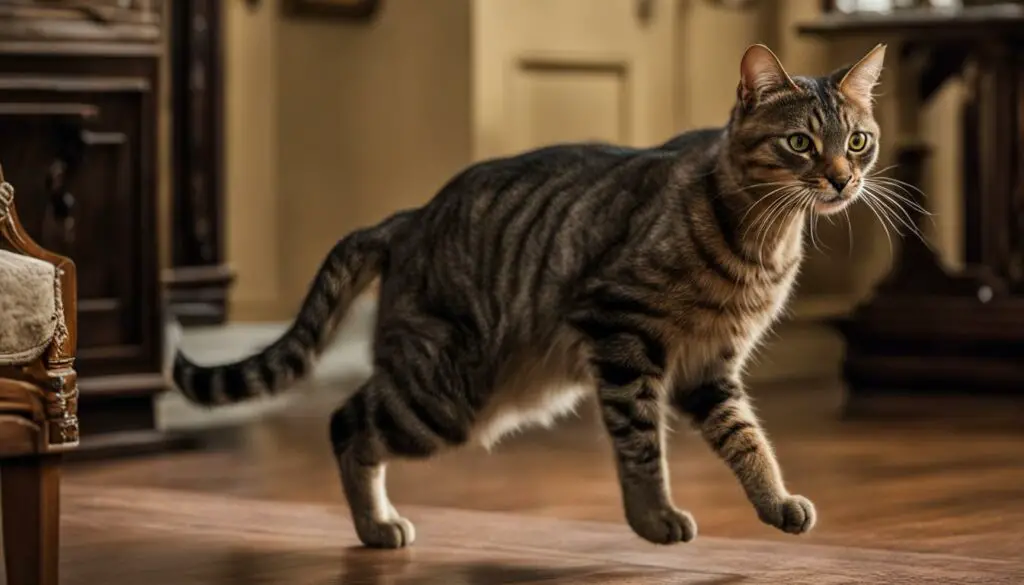
Understanding and addressing aggressive cat behavior requires the expertise of veterinary professionals who specialize in feline behavior. Consulting with a veterinarian or a veterinary behaviorist can provide valuable insights into the underlying causes of aggression and potential treatment options. These professionals can conduct thorough assessments, recommend behavior modifications, and discuss the potential risks and benefits of various approaches. They can also provide guidance on how to create a safe and enriching environment for the aggressive cat.
In summary, aggressive cat behavior is a complex issue that requires careful assessment and treatment. By understanding the signs and possible causes of aggression, implementing behavior modifications, and seeking guidance from veterinary professionals, cat owners can take meaningful steps towards managing and improving their cat’s aggressive behavior.
Challenges in Dealing with Aggressive Cats
Dealing with an aggressive cat can be a daunting task for pet owners. It poses risks to both their safety and the safety of others. When standard behavior modifications and medications don’t yield significant improvements, finding effective options for managing aggression can be especially challenging. However, there are still avenues to explore before considering euthanasia.
One option is aggressive cat rehabilitation, which involves working with behavior specialists to address the underlying causes of aggression. Rehabilitation programs often include behavior modification exercises, environmental enrichment, and positive reinforcement training. These programs aim to modify the cat’s behavior and teach them alternative ways to express themselves. It’s crucial to implement rehabilitation programs under the guidance of a veterinary behaviorist or a certified cat behavior consultant, as they have the expertise to design tailored plans for each cat.
Quote: “Rehabilitation programs have made a significant difference in my aggressive cat’s behavior. With the help of a veterinary behaviorist, we were able to identify triggers and work on redirecting his aggression. It took time and patience, but now he is much calmer and less prone to aggressive outbursts.” – Cat Owner
Aggressive cat training is another approach that pet owners can consider. This involves using positive reinforcement techniques to teach the cat acceptable behavior and redirect their aggression. Training sessions should focus on rewarding desirable actions and providing a safe space for the cat to learn new behaviors. Consistency and patience are key when training aggressive cats, as it may take time for them to respond and unlearn their aggressive tendencies.
It’s important to explore all available options for managing aggressive cats before making any decisions. Each cat is unique, and what works for one may not work for another. With the right professional guidance, dedication, and love, aggressive cat behavior can be successfully managed, providing a safer and happier environment for both the cat and their owners.

The Ethical Dilemma of Euthanizing an Aggressive Cat
When faced with an aggressive cat, pet owners may grapple with ethical considerations surrounding euthanasia. Putting down an aggressive cat is generally reserved for cases where the cat poses a severe risk to both humans and other animals. Veterinarians may consider euthanasia if the cat has attacked and drawn blood or if the cat has a medical condition that will result in suffering. However, this decision should never be taken lightly and should involve careful consideration of all available alternatives.
It is essential to prioritize the safety of both the cat and the individuals or animals it may harm. Euthanasia should only be considered when all other options for managing aggression have been exhausted and the cat’s behavior remains a significant risk. This decision should be made in consultation with both veterinary professionals and behavior specialists who can provide valuable insights into the cat’s behavior and potential treatment options.
While euthanasia may be a difficult and emotional decision, it is crucial to remember that it may be the most compassionate option in some cases. If an aggressive cat’s behavior cannot be modified, and it continues to pose a severe risk, euthanasia can prevent further harm and suffering. However, it is important to seek support from friends, family, or professional counselors to navigate the emotional challenges associated with this decision.
“Putting down an aggressive cat is a challenging decision, and it is essential to consider the well-being of both the cat and the surrounding environment. Euthanasia should only be seen as a last resort when all other alternatives have been explored and deemed insufficient.”
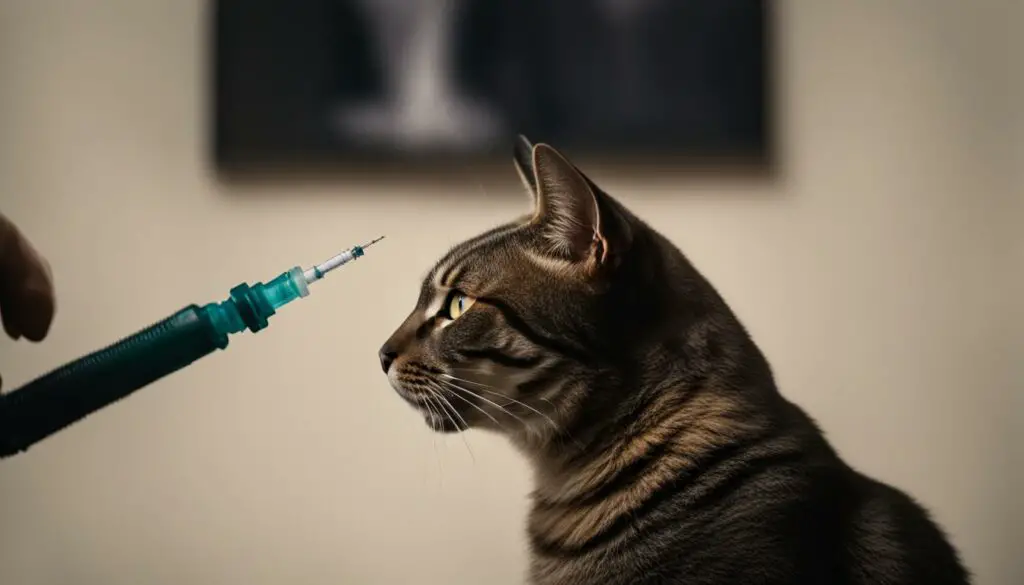
| Euthanasia Considerations for Aggressive Cats | Ethical Considerations |
|---|---|
| Aggressive behavior poses a severe risk to humans and animals | Ensuring safety for all involved parties |
| Behavior modification and medical interventions have been unsuccessful | Making a compassionate decision to prevent further suffering |
| The cat’s quality of life is significantly compromised | Weighing the benefits against the potential harm |
While euthanizing an aggressive cat is a difficult decision, it is crucial to prioritize the well-being and safety of all affected individuals. Seeking professional advice, exploring all available alternatives, and carefully considering the cat’s quality of life can help pet owners make an informed and compassionate choice.
Finding a Vet for Your Aggressive Cat
If you’re dealing with an aggressive cat, it’s essential to seek help from veterinary professionals who specialize in behavior management. Consulting with a veterinarian or a veterinary behaviorist can provide valuable insights into the underlying causes of aggression and potential treatment options. These professionals have the expertise to conduct thorough assessments, recommend behavior modifications, and discuss the potential risks and benefits of various approaches.
When choosing a vet for your aggressive cat, look for professionals who have experience working with feline behavior issues. They should be skilled in understanding the nuanced complexities of cat behavior and possess the necessary knowledge to develop personalized treatment plans. A veterinary behaviorist, in particular, is a veterinarian who has undergone additional training in animal behavior and can offer specialized expertise in dealing with aggression.
“Working with a veterinary professional who understands cat behavior can make a world of difference in managing aggression,” says Dr. Emily Johnson, a renowned veterinary behaviorist. “They have the skills and knowledge to develop a holistic approach tailored to your cat’s unique needs.”
In your consultation with the veterinary professional, be prepared to discuss your cat’s aggression history, triggers, and any other relevant information. This will help them assess the severity of the issue and recommend appropriate behavior modifications or medical interventions if necessary. Remember, finding the right vet who understands your cat’s specific aggression challenges can significantly improve the chances of successful management.
| Veterinary Professionals for Aggressive Cats | Services Provided | Location |
|---|---|---|
| Dr. Emily Johnson | Veterinary behaviorist with expertise in aggression | City A |
| Dr. Mark Thompson | Veterinarian with a special interest in feline behavior | City B |
| Dr. Sarah Mitchell | Experienced in behavior modification techniques | City C |
Exploring Rehabilitation Programs for Aggressive Cats
When it comes to managing aggressive cat behavior, rehabilitation programs can be an effective option. These programs aim to modify the cat’s behavior through various techniques, addressing the underlying causes of aggression and teaching the cat alternative behaviors. Rehabilitation programs for aggressive cats typically involve behavior modification exercises, environmental enrichment, and positive reinforcement training.

Under the guidance of a veterinary behaviorist or a certified cat behavior consultant, these programs can make a significant difference in the lives of aggressive cats. By providing a structured and supportive environment, rehabilitation programs help cats learn new ways to communicate and interact with their surroundings.
It’s important to note that rehabilitation programs require time, patience, and consistency. Each cat is unique, and progress may vary. However, with dedication and proper guidance, many aggressive cats can show improvements in their behavior and quality of life.
The Benefits of Rehabilitation Programs
Rehabilitation programs offer several benefits for aggressive cats and their owners. Firstly, these programs provide a safe and controlled environment for cats to practice appropriate behavior and learn to manage their aggression. Through behavior modification exercises and positive reinforcement, cats can develop new coping mechanisms and communication skills.
Additionally, rehabilitation programs focus on addressing the root causes of aggression rather than simply suppressing the behavior. By understanding the underlying factors contributing to the cat’s aggression, such as fear, anxiety, or territorial issues, these programs can create long-lasting change for the cat.
Rehabilitation programs also benefit cat owners by equipping them with the knowledge and tools to effectively manage their cat’s aggression. Owners learn to recognize triggers and implement appropriate strategies for redirecting their cat’s behavior. These programs empower owners to create a harmonious and safe environment for both their cat and their household members.
| Benefits of Rehabilitation Programs: |
|---|
| Provides a safe and controlled environment |
| Addresses the root causes of aggression |
| Equips owners with knowledge and tools |
Supportive Care for Aggressive Cats
Managing cat aggression requires a comprehensive approach that goes beyond behavior modification and medication. Supportive care plays a crucial role in creating a calm and enriched environment for aggressive cats. By implementing various techniques and strategies, pet owners can help reduce aggression and promote overall well-being in their feline companions.
Creating a Calm Environment
One of the key aspects of supportive care for aggressive cats is creating a calm and stress-free environment. This can be achieved by providing a designated safe space where the cat can retreat when feeling anxious or overwhelmed. This space should be equipped with comfortable bedding, hiding spots, and interactive toys to engage the cat in positive and stimulating activities. Additionally, minimizing loud noises and excessive human or animal interactions can help reduce stress and prevent aggressive episodes.
Implementing Consistent Routines
Establishing consistent routines can also contribute to managing cat aggression. Cats thrive on predictability and structure, so feeding, playtime, and grooming should be scheduled at the same time each day. Consistency in routines helps reduce anxiety and provides a sense of security for the cat. By maintaining regularity, pet owners can help minimize triggers that may lead to aggression.
Using Calming Techniques
Various calming techniques can be employed to help alleviate aggression in cats. Pheromone diffusers, such as Feliway, release natural scents that mimic the comforting pheromones produced by cats. These diffusers can create a soothing environment and help reduce stress-related aggression. Additionally, anxiety-reducing supplements or herbal remedies, when recommended by a veterinarian, may aid in calming aggressive behavior in cats.

| Supportive Care Strategies for Aggressive Cats | Benefits |
|---|---|
| Creating a calm environment | Reduces stress and triggers for aggression |
| Implementing consistent routines | Provides predictability and security |
| Using calming techniques | Alleviates anxiety and promotes relaxation |
Safety Precautions and Liability
When dealing with an aggressive cat, ensuring safety precautions is crucial for both the cat and the people around them. Here are some measures to consider:
1. Secure Confinement
Keeping the aggressive cat separated from visitors or other household members can help prevent any potential harm. It is advisable to create a designated area for the cat, such as a separate room, where they can feel secure and minimize the risk of unexpected aggression.
2. Behavior Aids
In some situations, using behavior aids like harnesses or muzzles can provide an extra layer of protection. These aids should only be used under professional guidance and when necessary, ensuring the safety of both the cat and people handling them.
3. Supervised Interactions
When allowing interactions between the cat and others, it is essential to closely supervise the interactions and ensure a controlled environment. This can help identify potential triggers for aggression and intervene promptly if needed.
| Safety Precautions | Benefits |
|---|---|
| Create a secure confinement area | Provides a safe space for the cat and minimizes the risk of aggression incidents |
| Use behavior aids such as harnesses or muzzles | Offers an added layer of protection during certain situations |
| Supervise interactions between the cat and others | Allows prompt intervention and identification of potential triggers |
“Safety measures are crucial when dealing with an aggressive cat. By taking necessary precautions such as secure confinement and using behavior aids, we can create a safer environment for everyone involved.” – Dr. Amanda Scott, DVM
Liability for Aggressive Cat Behavior
It is important for pet owners to be aware of potential liability issues related to their cat’s aggressive behavior. If the cat were to cause harm to another person or animal, the owner may be held responsible. Understanding and addressing these legal concerns is crucial to ensure the well-being and safety of both the cat and others.
In summary, implementing safety measures such as secure confinement, using behavior aids under professional guidance, and supervising interactions can help mitigate risks associated with aggressive cat behavior. Additionally, being aware of liability concerns can help pet owners take necessary precautions and act responsibly in ensuring the safety of others.
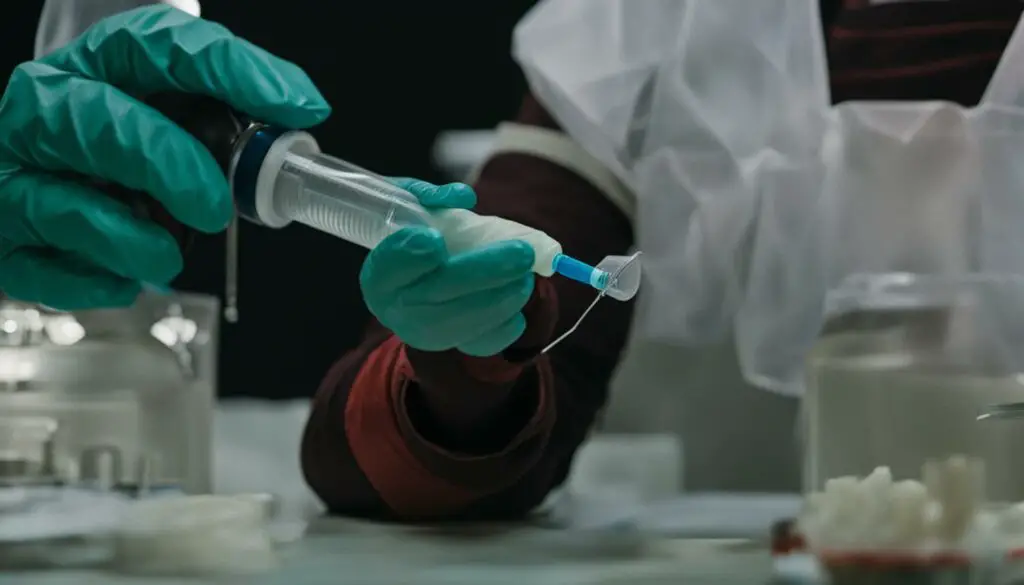
Exploring Rehoming Options for Aggressive Cats
Rehoming an aggressive cat can be a challenging process due to safety concerns and limited acceptance by rescue organizations or potential adopters. Many cat sanctuaries may also be unwilling to take in cats with a history of aggression. However, it is crucial to exhaust all possible rehoming options and carefully assess the potential risks to ensure the cat’s well-being in a new environment.
When attempting to find a new home for an aggressive cat, it is important to consider the cat’s specific needs and behaviors. Potential adopters should be informed about the cat’s aggression and provided with accurate information to make an informed decision. Additionally, it may be beneficial to work with rescue organizations or experienced fosters who specialize in aggressive cat rehabilitation, as they may have the knowledge and resources to handle these cases.
Some rehoming options for aggressive cats include reaching out to local no-kill shelters, behavioral rehabilitation centers, or specialized sanctuaries that have experience working with aggressive cats. However, it is essential to thoroughly research and evaluate these options to ensure they can provide the necessary care and environment that will address the cat’s aggression effectively.
Rehoming Options for Aggressive Cats
| Option | Description |
|---|---|
| No-kill shelters | No-kill shelters may be willing to take in aggressive cats and work on their behavior modification. They often have experienced staff and resources to manage and rehabilitate aggressive cats. |
| Behavioral rehabilitation centers | Specialized centers that focus on rehabilitating cats with behavioral issues, such as aggression. These centers provide tailored programs and expert guidance to modify the cat’s behavior and find suitable homes. |
| Specialized sanctuaries | Some sanctuaries cater specifically to cats with behavioral challenges. These sanctuaries have the knowledge and experience to provide lifelong care for aggressive cats in a safe and controlled environment. |
Rehoming an aggressive cat requires careful consideration, transparency, and collaboration with experienced individuals or organizations. It is essential to prioritize the cat’s safety and well-being, ensuring they are placed in an environment that can understand and address their specific needs. By exploring all available rehoming options and working with professionals, pet owners can provide a second chance to aggressive cats and improve their quality of life.
The Role of Veterinary Professionals in Rehoming Aggressive Cats
When it comes to rehoming aggressive cats, veterinary professionals play a crucial role in ensuring the well-being and successful transition of these cats to new environments. They provide valuable expertise, guidance, and recommendations to both potential adopters and rescue organizations. Through their involvement, they contribute to finding suitable solutions for cats who may otherwise face euthanasia due to their aggressive behavior.
Veterinary professionals can first conduct thorough behavior assessments and evaluations to determine the underlying causes of aggression in cats. This helps in developing personalized treatment plans and behavior modification strategies that can address the specific needs of each cat. By identifying the triggers and implementing appropriate interventions, veterinarians can increase the chances of successful rehabilitation and rehoming.
In addition, veterinary professionals can assist in the rehoming process by providing necessary documentation, such as medical records and behavior assessments, to potential adopters or rescue organizations. This documentation helps potential adopters understand the cat’s history, needs, and any ongoing treatment requirements. It also ensures transparency and ensures that the cat is placed in a suitable environment where their specific needs can be met.
Table: Veterinary Recommendations for Rehoming Aggressive Cats
| Recommendation | Description |
|---|---|
| Behavior Modification Techniques | Veterinarians may recommend specific behavior modification techniques, such as positive reinforcement training or desensitization, to help reduce aggressive behaviors in cats. |
| Environmental Enrichment | Creating a stimulating and enriching environment can help redirect a cat’s aggressive tendencies and provide mental and physical stimulation. |
| Medication | In some cases, veterinarians may prescribe medication to manage underlying medical conditions or to help reduce anxiety and aggression in cats. |
| Ongoing Support | Veterinarians may provide ongoing support and guidance to adopters or rescue organizations to ensure the cat’s successful transition and adjustment in their new home. |
The expertise and recommendations from veterinary professionals are invaluable in the rehoming process for aggressive cats. Their involvement ensures that these cats have the best chance of finding a suitable and understanding home where their specific needs can be met. By working collaboratively with adopters and rescue organizations, veterinary professionals contribute to the well-being and happiness of both cats and their new families.

Addressing Emotional Challenges for Pet Owners
Dealing with the decision to euthanize an aggressive cat can be an emotionally challenging experience for pet owners. The thought of putting down a beloved pet can evoke feelings of guilt, grief, and sadness. It’s important to acknowledge and address these emotions to make the best decision for both the cat and the owner’s well-being.
Euthanizing a pet is a deeply personal choice, and pet owners may question whether they have done everything they can to manage their cat’s aggression. It’s normal to feel guilty or wonder if there were other options to explore. However, it’s important to remember that owners are acting out of love and concern for their pet’s safety and the safety of others.
Seeking support from friends, family, or professional counselors can be immensely helpful during this difficult time. Talking openly about the decision and expressing feelings of guilt and grief can provide much-needed comfort and guidance. Additionally, joining online support groups or forums for pet owners who have faced similar challenges can offer a sense of community and understanding.
Understanding the Cat’s Quality of Life
Assessing the quality of life of an aggressive cat is a crucial step in making informed decisions about their well-being. It involves evaluating various factors that contribute to their overall welfare and happiness. By considering these aspects, pet owners can gain a better understanding of whether euthanasia is the most compassionate option to end the cat’s suffering.
When assessing a cat’s quality of life, it’s important to take into account their physical and emotional well-being. Physical factors include the cat’s overall health, any existing medical conditions, pain levels, appetite, and ability to perform natural behaviors. Emotional well-being involves considering the cat’s level of fear, stress, and anxiety, as well as their ability to experience positive emotions and engage in social interactions.
Table:
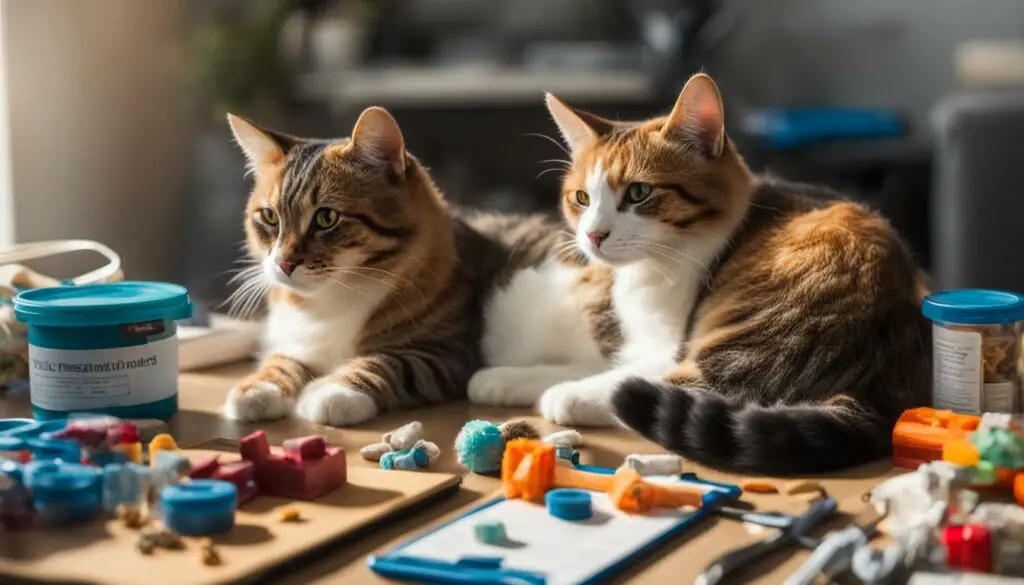
The table above provides a comprehensive overview of the key elements to assess when evaluating a cat’s quality of life. It highlights the different categories such as physical health, behavior, and environmental factors, along with specific indicators for each category. By carefully observing and rating these indicators, pet owners can gain valuable insights into the cat’s overall well-being.
Assessing a cat’s quality of life should be done in consultation with a veterinarian. They can provide expert guidance and help interpret the cat’s behavior and physical condition. Together, pet owners and veterinarians can determine the best course of action that prioritizes the cat’s welfare and ensures the most compassionate approach for their unique situation.
Exploring Alternatives to Euthanasia
When faced with the difficult decision of euthanizing an aggressive cat, it’s important to consider alternatives that prioritize the cat’s well-being. Cat sanctuaries and behavior rehabilitation centers offer potential options for providing lifelong care and rehabilitation to aggressive cats. These organizations specialize in understanding and working with cats who have behavioral challenges, providing them with the necessary care and support they need to thrive.
By partnering with cat sanctuaries, aggressive cats can be placed in environments where their specific needs can be met. These sanctuaries often have experienced staff who are trained in handling and managing aggressive behaviors. They are equipped with the knowledge and resources to implement behavior modification techniques that can help address aggression in cats.
Behavior rehabilitation centers also play a crucial role in providing alternatives to euthanasia. These centers focus on understanding the underlying causes of aggression and developing customized rehabilitation plans to help cats overcome their aggressive behaviors. Through structured training programs and positive reinforcement techniques, these centers can help aggressive cats learn new behaviors and improve their overall well-being.
Benefits of Cat Sanctuaries and Behavior Rehabilitation Centers:
- Specialized care and expertise in managing aggressive cat behavior
- Structured behavior modification programs tailored to the cat’s specific needs
- Enriched environments that promote mental and physical stimulation
- Experienced staff who understand the challenges and complexities of aggressive cat behavior
- Potential for lifelong care and rehabilitation in a safe and supportive environment
While exploring alternatives to euthanasia, it’s crucial to thoroughly research and assess the reputation and track record of cat sanctuaries and behavior rehabilitation centers. It’s important to ensure that these organizations have a proven history of successfully rehabilitating aggressive cats and providing them with a high quality of life. By exploring these alternatives, pet owners can make informed decisions that prioritize the well-being and happiness of their aggressive cats.

Pet Owner Stories and Experiences
Real-life experiences of pet owners who have dealt with aggressive cats can provide valuable insights into the challenges faced and the decisions made. These stories offer a glimpse into the emotional rollercoaster that comes with managing aggressive cat behavior. Hearing from others who have gone through similar situations can provide comfort and support for those currently navigating the difficult journey of dealing with an aggressive cat.
“My cat, Oliver, was always docile and friendly until he turned two years old. Suddenly, he began displaying aggressive behavior towards me and my other pets. I was at a loss for what to do and felt guilty that I couldn’t control his aggression. After seeking advice from a veterinary behaviorist, I learned that Oliver was dealing with fear-based aggression. With their guidance, I implemented behavior modification techniques and created a safe and enriched environment for him. It took time and patience, but Oliver’s aggression has significantly improved, and he’s now a much happier cat.”
These personal stories serve as a reminder that addressing aggression in cats requires a comprehensive approach tailored to their unique needs. While it can be a challenging and sometimes overwhelming journey, with the right strategies and support, there is hope for managing and improving aggressive cat behavior.

In addition to learning from the experiences of others, it’s crucial for pet owners to remember that every cat is different, and what works for one may not work for another. Consulting with a veterinary professional or a certified cat behavior consultant is essential for developing a personalized plan to address aggression. These experts can provide guidance, behavioral assessments, and recommend appropriate treatment options based on their expertise and knowledge.
Conclusion
Managing aggressive cat behavior can be a challenging and emotionally demanding journey for pet owners. While euthanasia may be considered in severe cases, it should always be the last resort. As I have discussed in this article, there are various alternatives and strategies to explore before making such a decision.
Understanding the underlying causes of aggression and seeking help from veterinary professionals are essential steps in managing aggressive cat behavior. Rehabilitation programs, including behavior modification exercises and environmental enrichment, can provide effective solutions for addressing the root causes of aggression.
Additionally, it is crucial to prioritize safety precautions and liability concerns when dealing with an aggressive cat. By implementing secure confinement measures and using behavior aids when necessary, pet owners can ensure the well-being of both the cat and others.
Finally, exploring rehoming options and seeking support from specialized cat sanctuaries or behavior rehabilitation centers can offer lifelong care and rehabilitation for aggressive cats. These alternatives, combined with the support of professional counselors and the sharing of real-life experiences from other pet owners, can provide comfort and guidance throughout this challenging journey.
FAQ
Will a vet put down an aggressive cat?
Veterinarians may consider euthanasia for aggressive cats in severe cases where the cat poses a severe risk to humans and other animals, or if the cat has a medical condition that will result in suffering. However, euthanasia should always be the last resort and alternative options should be explored.
What are the options for managing aggressive cats?
Managing aggressive cats requires a comprehensive approach that may include behavior modifications, medication, and environmental changes. Rehabilitation programs, working with behavior specialists, and implementing training techniques can all be part of managing aggressive cat behavior.
How can I deal with an aggressive cat?
Dealing with an aggressive cat can be challenging. It’s important to prioritize safety precautions, seek professional help from veterinary experts, and implement behavior modifications, environmental enrichment, and positive reinforcement training techniques. Supportive care and addressing legal concerns related to the cat’s behavior are also crucial.
What are the ethical considerations of euthanizing an aggressive cat?
Euthanizing an aggressive cat is generally reserved for cases where the cat poses a severe risk to humans and other animals or if the cat has a medical condition that will result in suffering. However, this decision should never be taken lightly and should involve careful consideration of all available alternatives.
How can I seek help from veterinary professionals for my aggressive cat?
Consulting with a veterinarian or a veterinary behaviorist can provide valuable insights into the underlying causes of aggression and potential treatment options. These professionals can conduct thorough assessments, recommend behavior modifications, and discuss the potential risks and benefits of various approaches.
Are there rehabilitation programs for aggressive cats?
Yes, rehabilitation programs for aggressive cats aim to modify their behavior through various techniques such as behavior modification exercises, environmental enrichment, and positive reinforcement training. These programs should be implemented under the guidance of a veterinary behaviorist or a certified cat behavior consultant.
What is supportive care for aggressive cats?
Supportive care for aggressive cats involves creating a calm and enriched environment, implementing consistent routines, providing mental and physical stimulation, and using calming techniques such as pheromone diffusers or anxiety-reducing supplements. Supportive care can complement behavior modification efforts and promote overall well-being in aggressive cats.
How can I address safety precautions and liability with an aggressive cat?
It’s important to prioritize safety precautions when dealing with an aggressive cat, which may involve keeping the cat separate from visitors or housemates, implementing secure confinement measures, and using behavior aids such as harnesses or muzzles when necessary. Additionally, pet owners should be aware of potential liability issues related to the cat’s aggressive behavior.
What are the rehoming options for aggressive cats?
Rehoming an aggressive cat can be challenging due to safety concerns and limited acceptance by rescue organizations or potential adopters. Many cat sanctuaries may also be unwilling to take in cats with a history of aggression. Exhausting all possible rehoming options and carefully assessing the potential risks is important.
How can veterinary professionals assist in rehoming aggressive cats?
Veterinary professionals can provide necessary documentation, behavior assessments, and recommendations to potential adopters or rescue organizations. They can also assist in finding suitable sanctuaries or alternative options for cats who are unable to be rehomed due to their aggression. Collaboration between pet owners, veterinarians, and rescue organizations is vital in ensuring the successful transition of aggressive cats to a new environment.
How can I address the emotional challenges of euthanizing an aggressive cat?
Pet owners facing the decision to euthanize an aggressive cat often experience emotional turmoil, including guilt, grief, and sadness. Seeking support from friends, family, or professional counselors can provide much-needed comfort and help pet owners navigate through the difficult emotions associated with euthanizing an aggressive cat.
How can I assess the quality of life of an aggressive cat?
When considering euthanasia for an aggressive cat, it’s essential to evaluate the cat’s overall quality of life. Cats who experience constant fear, anxiety, or aggression may not be leading fulfilling lives. Consultation with a veterinarian can help assess the cat’s welfare and determine whether euthanasia is the most compassionate option to end their suffering.
Are there alternatives to euthanizing an aggressive cat?
Before making the final decision to euthanize an aggressive cat, exploring alternatives is crucial. This may involve reaching out to specialized cat sanctuaries or behavior rehabilitation centers that have experience working with aggressive cats. While these alternatives may not always be feasible or readily available, they offer potential options for providing lifelong care and rehabilitation to aggressive cats.
What can I learn from pet owner stories and experiences with aggressive cats?
Pet owners who have dealt with aggressive cats have shared their experiences and stories online. These anecdotes can offer valuable insights into the challenges faced, the decisions made, and the emotional toll of dealing with an aggressive cat. Hearing these real-life experiences can provide comfort and support to pet owners who are navigating the difficult journey of managing aggressive cat behavior.
Source Links
- https://www.vet.cornell.edu/departments-centers-and-institutes/cornell-feline-health-center/health-information/feline-health-topics/feline-behavior-problems-aggression
- https://www.reddit.com/r/Pets/comments/1echt0/aggressive_cat_coming_down_to_euthanasia_or_a/
- https://www.dvm360.com/view/treat-or-euthanize-helping-owners-make-critical-decisions-regarding-pets-with-behavior-problems

